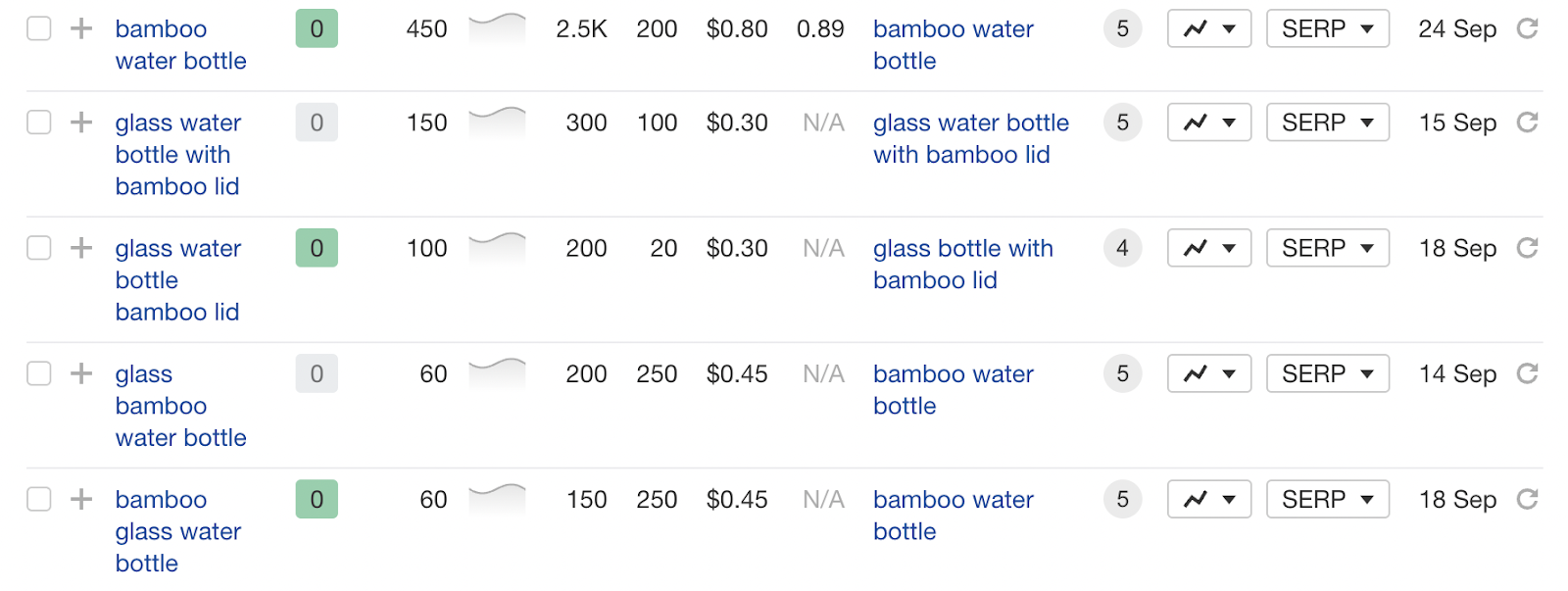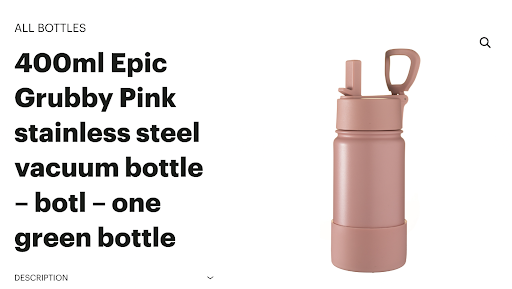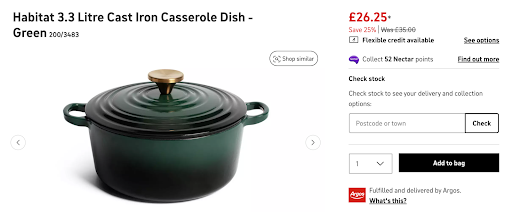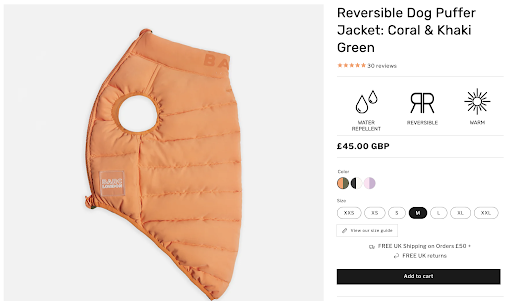Art of the Product Title: Optimization Tips (With Winning Examples)

Your product titles are often the first thing a shopper sees, whether that’s in the search results or at the top of your product page. If the title doesn’t convey the right information quickly, you could lose a potential customer's interest — maybe forever.
Product titles are more important than you think. Sixty-two percent of German shoppers, 65% of Australian shoppers, 67% of French shoppers, 68% of British shoppers, and 72% of U.S. shoppers cite the quality of product titles and product descriptions as an important factor in their purchasing decisions per Salsify “2023 Shopper Research.”
Understanding product title optimization is challenging if you don’t know what to include or how much information you need to cover. Here's what makes a winning product title — and a handful of real-life product title examples you can pull inspiration from.
The Essential Parts of a Product Title
Product titles tell shoppers what a product is, if it’s what they’re looking for, and how it’s different from the competition. Search engines will often use the title to determine whether to show your product to consumers based on the phrases they use in their search. Get it wrong, and your products might be relegated to the dark depths of page two or three of the search engine results pages (SERPs), no matter how good they are.
On top of this, Salsify research shows that 36% of shoppers say accurate and robust product information boosts their trust in a new retailer. So what does “accurate and robust” look like?
It starts by including some essential information in your product titles:
- The main keyword: This is the word that best describes your product and is most related to what your product is (e.g., shoe, bag, or bottle).
- Top features: Highlighting the specific features your product has will help shoppers find what they’re looking for (e.g., dog-friendly, reversible, or vegan).
- Size or defining attributes: Including information like ingredients, color, and size can help shoppers narrow down their search (e.g., 500ML, red, or stainless steel).
How To Write a Winning Product Title: A Step-By-Step Guide
Now that you know what elements make up a good product title, learn how to write something that speaks to your audience and describes your product.
Keyword Research
Injecting your product titles with relevant keywords will help search engines better understand what you’re selling. This means they’re more likely to bump your listing up the results page if it matches what a shopper is searching for.
Consider using a keyword tool like Ahrefs or SEMRush to find keywords associated with your product — in particular, look for phrases with a high search volume but low competition.
 Image Source: Ahrefs
Image Source: Ahrefs
Ahrefs shows that “bamboo water bottle” and the more descriptive “glass water bottle with bamboo lid” have relatively high search volumes and very little competition. Product search engine optimization (SEO) is an important activity for boosting the discoverability of your products in the SERPs.
Highlight Defining Features
As well as highlighting what your product is, you can use your product title to set it apart from the competition. Do this by listing its main features, like size, color, potential uses, or any ingredients that make it unique.
For example, using the example of the bamboo water bottle above, you could expand the title to include the bottle size and color: “Glass water bottle with bamboo lid | 500ML | Teal.” This could help shoppers make an instant decision about whether your product is the right fit.
Make Your Product Title Descriptive
The more you can describe your product in the title, the better. The example above basically lists a load of features and keywords, and while this can be great for getting the attention of search engines, it can also be confusing for shoppers.
Instead, use the keywords and important features as your “pillars” and then create a descriptive story around them to engage with potential shoppers. For example, “500ML Teal Glass Water Bottle With Bamboo Lid | Perfect for Camping and Sports.”
7 Tips for Product Title Optimization
Ready to start writing your product titles? How about tackling product title optimization? Here are some tips to ensure they’re the best they can be.
1. Explicitly List Main Features
Before you start crafting or optimizing your title, spend some time deciding on the product's main features. Be sure to list them explicitly. You can even dig into past reviews here to see what words customers use to describe the product and which features they mention the most.
2. Analyze Similar Product Titles
Run a search for your product on a retailer like Amazon or a search engine to see what product titles look like for similar results. Make a note of defining features or any that stand out — you can replicate the winning elements in your own titles.
3. Use Long-Tail Keywords
Long-tail keywords are usually three or more words in length and go into more detail about your product. For example, “water bottle” is not a long-tail keyword, but “glass water bottle with bamboo lid” is. Long-tail keywords tend to attract high-intent shoppers who know exactly what they’re looking for and are, therefore, more likely to buy.
4. A/B Test Your Product Titles
The first version you write doesn’t have to be the last. Test variations that include long-tail keywords, different features, and a mash-up of keywords to see which ones get the most clicks and conversions.
5. Keep It Short and Concise
Shoppers will lose interest if your product titles are too long. Attention spans are at an all-time low, and most people will only read the first and last items in a sentence due to a phenomenon called the serial position effect per CXL, a marketing agency and hub.
Keep your title concise — ideally, no more than 100 characters.
This isn’t just to appease shorter attention spans but also to appease search engines. Most SERPs cut off titles over a certain length, meaning shoppers might miss out on crucial information.
6. Don’t Keyword Stuff
While keywords can help shoppers and search engines get a feel for your products, there can be too much of a good thing. Adding too many keywords to your product titles can be detrimental — the SERPs penalize keyword-stuffing, and shoppers will quickly realize you’re trying to game the rankings rather than describing your product to them.
7. Check Spelling and Grammar
Finally, make sure you check the spelling and grammar of your product titles are correct. The last thing you want is to miss out on sales or make meticulous shoppers wary because you’ve misspelled a word.
5 Product Title Examples From Different Ecommerce Verticals
Sometimes, you need to see something in action for it to click. Here are some product title examples from a variety of ecommerce brands in different industries for inspiration.
Once you’ve checked out these examples, why not explore some top product description examples for full product page inspiration?
1. Fishwife’s Elaborate Anchovies

Image Source: Fishwife
Fishwife’s product titles include what the product is (anchovies) as well as descriptive factors like where the anchovies are from and the ingredients used.
2. RIHOAS’ Dress Description for Success
 Image Source: RIHOAS
Image Source: RIHOAS
RIHOAS goes all in on describing this dress. The title includes the color, neck shape, hem length, pattern, and material in a way that doesn’t feel overstuffed.
3. One Green Bottle’s Size Statement
 Image Source: One Green Bottle
Image Source: One Green Bottle
One Green Bottle concisely states the main features in its product title, including the bottle size, color, and material.
4. Habitat’s Hefty Highlight
 Image Source: Habitat
Image Source: Habitat
Habitat uses a similar format to One Green Bottle, highlighting the product’s size, material, and color.
5. Barc’s Savvy Selling Point
 Image Source: Barc
Image Source: Barc
Barc uses a slightly different product title format. It leads with the unique selling point (USP) of the product (reversible) and follows that up with the style and color.
Give Your Products the Product Titles They Deserve
Remember, your product titles are often the first thing a shopper sees — they have a significant role to play. As well as highlighting what exactly the product is, your product titles should set you apart from the competition and encourage shoppers to click through from the search results.
Make sure you include all the relevant information, like attributes and keywords, but most importantly, keep it short and sweet.

How To Write Great (Not OK) Product Copy
Want to write better product titles and descriptions? Download Salsify’s guide to learn how to engage shoppers and boost product discovery.
DOWNLOAD GUIDEWritten by: Lizzie Davey
Lizzie Davey (she/her) is a freelance writer and content strategist for ecommerce software brands. Over the past 10 years, she's worked with top industry brands to bring their vision to life and build optimized and engaging content calendars.
Recent Posts
Ecommerce Marketing
|
12 minute read
The Art of the Impulse Buy: 70% of Shoppers Say Discounts Drive Unplanned Purchases — Here’s Why
Read More
Ecommerce Marketing
|
10 minute read
What Does It Take To Have a Good Brand Reputation in 2025?
Read More
Ecommerce Trends
|
11 minute read
What Is Commerce Media — and How Can It Optimize Your Marketing Spend?
Read More
Subscribe to the Below the Fold Newsletter
Standing out on the digital shelf starts with access to the latest industry content. Subscribe to Below the Fold, our monthly content newsletter, and join other commerce leaders.
Write Product Copy That’s Better Than ‘Eh’
Download Salsify’s guide to learn how to engage shoppers and boost product discovery.
DOWNLOAD GUIDE

.svg)